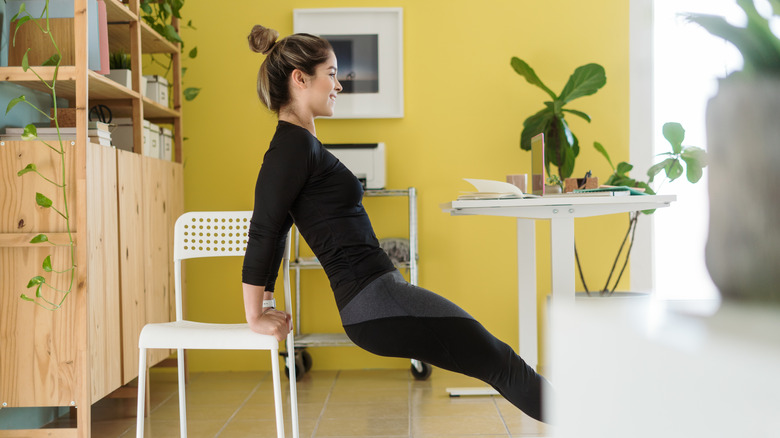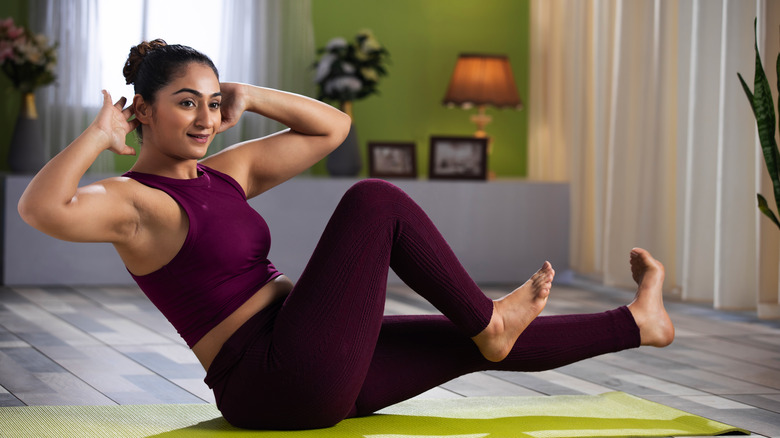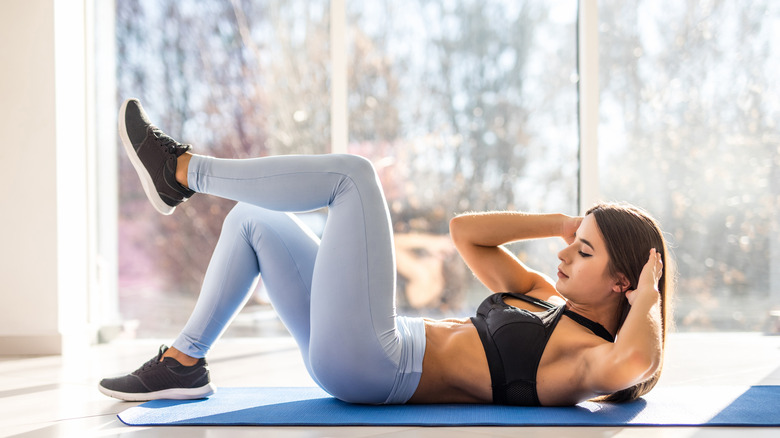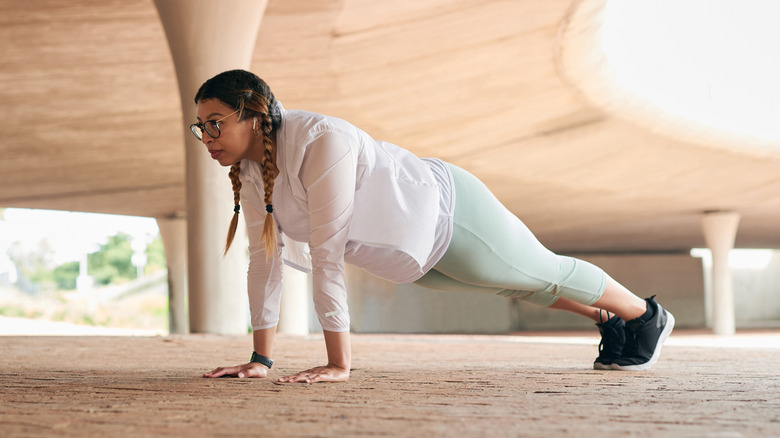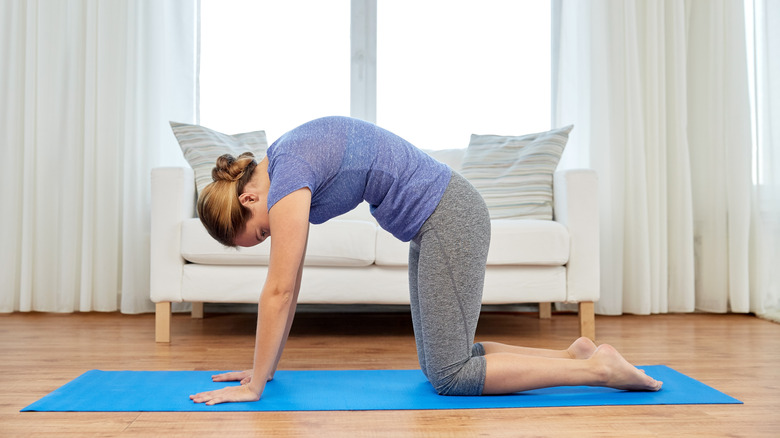Abdominal Exercises You Can Do At Your Desk To Create A Killer Core
If we're being honest, we all spend way too much time sitting at our desks. But looming deadlines, mouse movement trackers, and work, in general, make it hard to unchain ourselves from our office spaces. Fortunately, a few creative fitness experts have developed abdominal exercises you can do at your desk to strengthen your core.
Whether you're dreaming of swimsuit season or simply want your abdominals to be more supportive, these moves are great for tightening and toning. Plus, they're an excellent way to fit some healthy movement into your packed schedule. Even if you don't desire a killer core, taking breaks for physical activity can help combat the negative health effects of prolonged sitting — does low back and shoulder pain sound familiar? A break is something everyone can benefit from.
It just so happens that ab work is one fitness category that doesn't rely on a gym, making it ideal for when you want to get in a workout while planted in your office chair. Some of these movements won't even tip off your coworkers that you're getting swimsuit-ready in your seat. So pack up your excuses and get ready to activate your core while you discreetly sit at your desk.
At-work warm-up
After completing every exercise in this list, you'll have done one round. Try to fit in at least three rounds.
Toe taps are an excellent warm-up that can help engage your abdominals and set the tone for your mini-office workout. Sitting up in your chair with a tall spine, pull your abdominals in towards your back (per Elle). Slowly raise one foot until it is about 6 inches from the ground. Hold it for 10 seconds, and then repeat with the other leg. Focus on your lower abs doing the lifting, not your hip joint. During each raise and lower of your leg, breathe deeply, remembering to keep your core strong and pulled in. Aim for 10 reps.
The next move is a sprinkler twist, which focuses on warming up your oblique muscles. As Stand Up Desk Store explains, while still sitting upright, gently set your hands where your neck meets the back of your head, as if you were going to do a crunch. Pull in your abs and firmly root your buttocks to the seat. On an exhale, twist your torso to one side and then the other, without lifting your buttocks off the chair. Hold for a few seconds on each side, then return to the center. You should only twist through your core and shoulders while keeping your hips and lower body still. Aim for 20 reps.
Lower ab focus
Now that you're warmed up, it's time to work on your lower abs and deep abdominals.
Reverse crunches target these areas and are easier to perform sitting than you may think. As Elle explains, scoot to the front of your chair just enough to slightly lean back while still feeling stable. Grab either side of the base of your chair and recline your torso. Extend both legs to align with your hips, keeping your feet together. Finally, draw them back into your torso like you're doing a crunch. Continue this extension until you have done 15 reps.
Seated leg raises are a more advanced form of toe taps. Assume the same position used for reverse crunches, like Skimble suggests, grasping the chair base and reclining back. With your feet firmly stuck together, extend your legs out so your heels are resting on the floor. Using your lower abs, raise both legs up as close to hip height as possible. Hold the position for a 1 to 2 second count and then lower your legs back to the floor. Once again, continue the movement until you have completed 15 reps.
Obliques and upper abs
We've worked the lower abs, so on to the upper abs and your obliques, which are the muscles on the sides of your waist.
For seated bicycle crunches, you'll want to assume the same reclined position as before, with your butt on the edge of the seat, per Elle. Extend your legs out with your heels on the ground and lean back. Instead of grabbing the sides of your chair, place both hands behind your head in the traditional crunch position. Draw your left knee up and in as if you were trying to touch your right shoulder. At the same time, twist your right shoulder towards your knee, crunching down and across. Sit up straight and extend your leg out to return to the starting position before repeating the movement on the other side. Aim for 20 reps.
If your chair isn't sturdy, you may want to use your desk for a plank hold. To do this pose properly, Elle notes you should place your hands shoulder-width apart on the edge of your desk or your chair. Walk your legs out behind you so you are on your toes with your heels off the floor. Avoid the number one plank mistake and keep your body in a straight line from your crown to your heels, on a 45-degree angle. Hold this position, drawing in your core to your back and tucking your pelvis slightly. After a 30 to 60-second hold, release.
Try some deep breathing
Deep breathing is great for core strength. It can help you activate your muscles and retain a pulled-in posture to support your entire torso. As a bonus, breathing exercises can be a nice way to relax at your desk before you dive back into work.
The Cleveland Clinic explained that diaphragmatic breath is when you put focus on breathing in and out by using, as you probably guessed, your diaphragm. Doing so can help relieve stress, improve muscle function, lower blood pressure, and oxygenate blood. To start, sit up straight in your chair with both feet on the ground. Relax your shoulders and let go of any tension. Place one hand on your heart or upper chest and the other on your stomach directly below your rib cage. You can close your eyes if you wish.
Slowly breathe in through your nose, feeling your stomach expand. Hold for a moment, then exhale through pursed lips while you draw in your core, feeling the hand on your stomach moving back in. Repeat for 5-10 breaths.
Engage your core
Using deep breathing, you can do some core engagement. Roll backs are very similar to the yoga Cat-Cow pose. Per Live Strong, scoot to the front of your chair and sit with a tall posture, thighs at hips distance and feet on the floor. Bring both arms up to shoulder height and take a deep breath in, feeling your abs and lower ribs expand. Then, slowly blow it out, pulling in your abdominals and rounding forward at the chest. Send your hips backward with a slight tilt as you do so, forming a "C" with your torso. Finally, pause for a few seconds then breathe in as you return to the starting position.
Almost everyone knows that core work can help define your abs, often a goal heading into the summer season. But your abdominals are important for reasons beyond looking fabulous in a swimsuit. Your core muscles are essential for good posture. Poor abdominal strength can lead to lazy posture, including slouching and hunching. And we probably don't have to tell you the outcome — neck, shoulder, and back pain. Getting in a few reps of abdominal work at your desk helps you strengthen and tighten those tummy muscles and reminds you to maintain proper posture throughout the day for fewer aches and pains. Throw in a glute desk workout or a few shoulder and arm exercises and you'll have a full-body workout from the comfort of your office.
